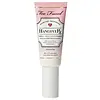What's inside
What's inside
 Key Ingredients
Key Ingredients

 Benefits
Benefits

 Concerns
Concerns

 Ingredients Side-by-side
Ingredients Side-by-side

Water
Skin ConditioningButylene Glycol
HumectantGlycerin
HumectantPEG-150 Distearate
EmulsifyingPolysorbate 80
EmulsifyingNiacinamide
SmoothingRosmarinus Officinalis Leaf Water
MaskingMelissa Officinalis Flower/Leaf/Stem Water
Skin ConditioningMentha Piperita Leaf Water
Skin ConditioningSodium Hyaluronate
HumectantSodium Ascorbyl Phosphate
AntioxidantMenthol
MaskingPentylene Glycol
Skin ConditioningPropylene Glycol
HumectantPEG-240/Hdi Copolymer Bis-Decyltetradeceth-20 Ether
StabilisingPEG-40 Hydrogenated Castor Oil
EmulsifyingPhenoxyethanol
PreservativeEthylhexylglycerin
Skin ConditioningCaprylyl Glycol
EmollientDisodium EDTA
Trideceth-9
Emulsifying1,2-Hexanediol
Skin ConditioningCI 42090
Cosmetic ColorantCI 19140
Cosmetic ColorantWater, Butylene Glycol, Glycerin, PEG-150 Distearate, Polysorbate 80, Niacinamide, Rosmarinus Officinalis Leaf Water, Melissa Officinalis Flower/Leaf/Stem Water, Mentha Piperita Leaf Water, Sodium Hyaluronate, Sodium Ascorbyl Phosphate, Menthol, Pentylene Glycol, Propylene Glycol, PEG-240/Hdi Copolymer Bis-Decyltetradeceth-20 Ether, PEG-40 Hydrogenated Castor Oil, Phenoxyethanol, Ethylhexylglycerin, Caprylyl Glycol, Disodium EDTA, Trideceth-9, 1,2-Hexanediol, CI 42090, CI 19140
Water
Skin ConditioningLactobacillus/Salix Alba Bark Ferment Filtrate
AntioxidantPropanediol Dicaprylate
EmollientPropanediol
SolventCeteareth-6 Olivate
EmulsifyingOlive Glycerides
EmulsifyingLactobacillus Ferment
Skin ConditioningAluminum Starch Octenylsuccinate
AbsorbentMicrocrystalline Cellulose
AbsorbentHydrogenated Olive Oil
Skin ConditioningPolyacrylate Crosspolymer-6
Emulsion StabilisingCellulose Gum
Emulsion StabilisingOlea Europaea Fruit Oil
MaskingPectin
Emulsion StabilisingTrisodium Ethylenediamine Disuccinate
Xanthan Gum
EmulsifyingOlea Europaea Oil Unsaponifiables
Skin ConditioningCocos Nucifera Fruit Juice
EmollientLauryl Alcohol Diphosphonic Acid
Emulsion StabilisingPentylene Glycol
Skin ConditioningGlycerin
HumectantLecithin
EmollientMagnesium Aluminum Silicate
AbsorbentParfum
MaskingLauric Acid
CleansingTocopherol
AntioxidantAscorbyl Palmitate
AntioxidantCitric Acid
BufferingWater, Lactobacillus/Salix Alba Bark Ferment Filtrate, Propanediol Dicaprylate, Propanediol, Ceteareth-6 Olivate, Olive Glycerides, Lactobacillus Ferment, Aluminum Starch Octenylsuccinate, Microcrystalline Cellulose, Hydrogenated Olive Oil, Polyacrylate Crosspolymer-6, Cellulose Gum, Olea Europaea Fruit Oil, Pectin, Trisodium Ethylenediamine Disuccinate, Xanthan Gum, Olea Europaea Oil Unsaponifiables, Cocos Nucifera Fruit Juice, Lauryl Alcohol Diphosphonic Acid, Pentylene Glycol, Glycerin, Lecithin, Magnesium Aluminum Silicate, Parfum, Lauric Acid, Tocopherol, Ascorbyl Palmitate, Citric Acid
 Reviews
Reviews

Alternatives
Ingredients Explained
These ingredients are found in both products.
Ingredients higher up in an ingredient list are typically present in a larger amount.
Glycerin is already naturally found in your skin. It helps moisturize and protect your skin.
A study from 2016 found glycerin to be more effective as a humectant than AHAs and hyaluronic acid.
As a humectant, it helps the skin stay hydrated by pulling moisture to your skin. The low molecular weight of glycerin allows it to pull moisture into the deeper layers of your skin.
Hydrated skin improves your skin barrier; Your skin barrier helps protect against irritants and bacteria.
Glycerin has also been found to have antimicrobial and antiviral properties. Due to these properties, glycerin is often used in wound and burn treatments.
In cosmetics, glycerin is usually derived from plants such as soybean or palm. However, it can also be sourced from animals, such as tallow or animal fat.
This ingredient is organic, colorless, odorless, and non-toxic.
Glycerin is the name for this ingredient in American English. British English uses Glycerol/Glycerine.
Learn more about GlycerinPentylene glycol is typically used within a product to thicken it. It also adds a smooth, soft, and moisturizing feel to the product. It is naturally found in plants such as sugar beets.
The hydrophilic trait of Pentylene Glycol makes it a humectant. As a humectant, Pentylene Glycol helps draw moisture from the air to your skin. This can help keep your skin hydrated.
This property also makes Pentylene Glycol a great texture enhancer. It can also help thicken or stabilize a product.
Pentylene Glycol also acts as a mild preservative and helps to keep a product microbe-free.
Some people may experience mild eye and skin irritation from Pentylene Glycol. We always recommend speaking with a professional about using this ingredient in your routine.
Pentylene Glycol has a low molecular weight and is part of the 1,2-glycol family.
Learn more about Pentylene GlycolWater. It's the most common cosmetic ingredient of all. You'll usually see it at the top of ingredient lists, meaning that it makes up the largest part of the product.
So why is it so popular? Water most often acts as a solvent - this means that it helps dissolve other ingredients into the formulation.
You'll also recognize water as that liquid we all need to stay alive. If you see this, drink a glass of water. Stay hydrated!
Learn more about Water